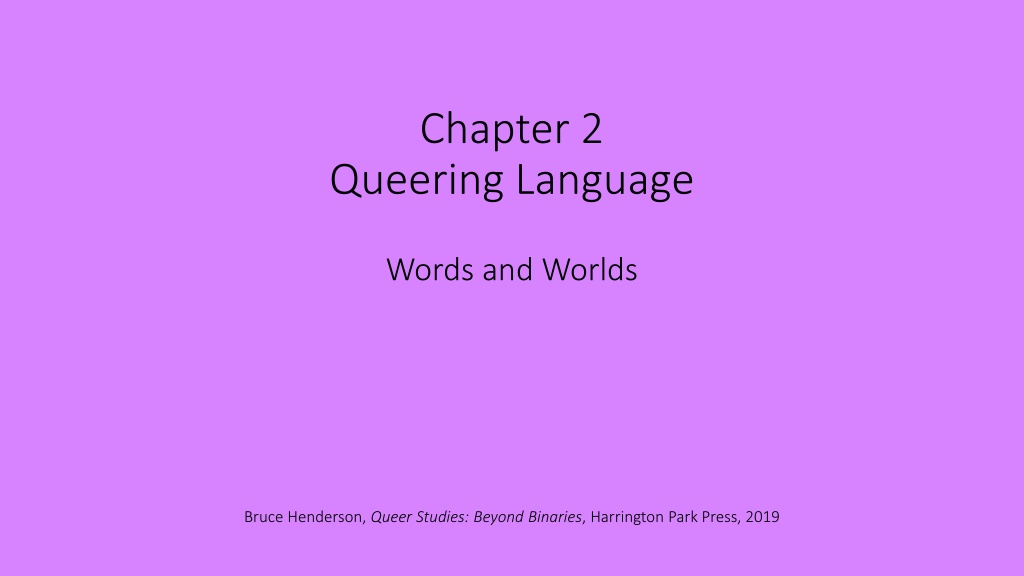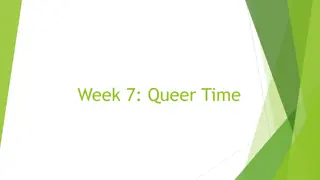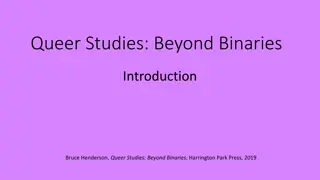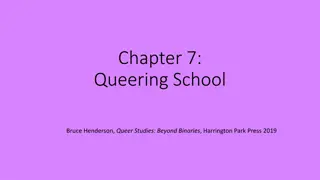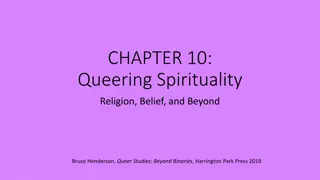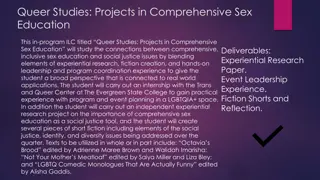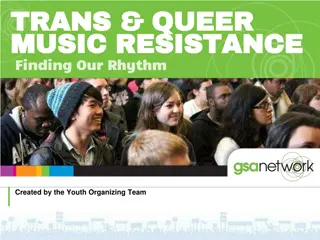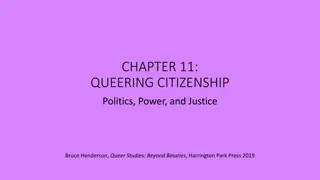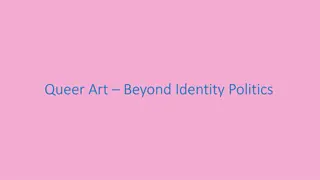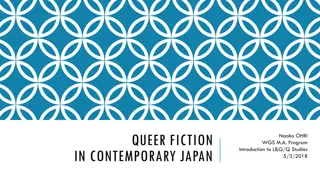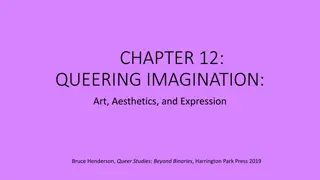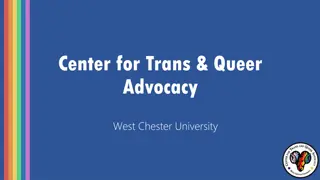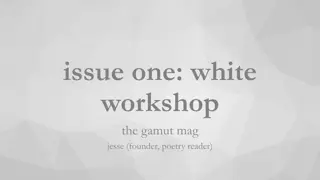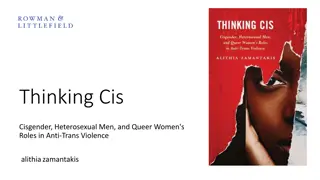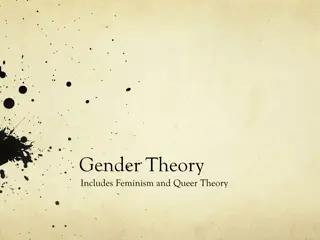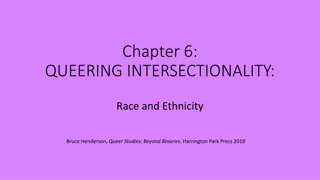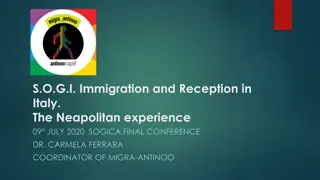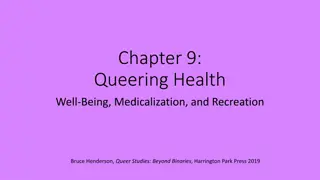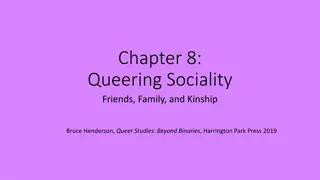Exploring Queer Language and World
Examining the linguistic aspects of queerness, this content delves into the history and evolution of terms like queer and homosexual. It discusses the reclaiming of queer identity, its association with leftist politics, and the linguistic reclamation process. Various perspectives on queer terminology, including its broadness, fluidity, and inclusiveness versus specificity and visibility within the LGBTQIA+ community, are explored. Additionally, the study of diachronic and synchronic linguistics in analyzing language change and variation over time is highlighted.
Download Presentation

Please find below an Image/Link to download the presentation.
The content on the website is provided AS IS for your information and personal use only. It may not be sold, licensed, or shared on other websites without obtaining consent from the author. Download presentation by click this link. If you encounter any issues during the download, it is possible that the publisher has removed the file from their server.
E N D
Presentation Transcript
Chapter 2 Queering Language Words and Worlds Bruce Henderson, Queer Studies: Beyond Binaries, Harrington Park Press, 2019
Linguistics: The Study of Language Diachronic linguistics: the study of language change across time Synchronic linguistics: Bruce Henderson, Queer Studies: Beyond Binaries, Harrington Park Press, 2019 The study of language variation within a single time period Bruce Henderson, Queer Studies: Beyond Binaries, Harrington Park Press, 2019
Queer: Whats in a Word? Queer vs LBTQIA+ : what is at stake? Broadness, fluidity, and inclusiveness ( queer ) Specificity, group identity, and visibility ( LGBTQIA+) Bruce Henderson, Queer Studies: Beyond Binaries, Harrington Park Press, 2019
Queer: The History of a Word Etymology: (Source: Brontsema) Originally mean differentness or strangeness Derived from Middle High German, twer, meaning cross or oblique Bruce Henderson, Queer Studies: Beyond Binaries, Harrington Park Press, 2019
Homosexual: Originally, an adjective referring to acts (not a category of person) In 20th century, also became a noun, used to identify a stable category of personhood (source: Michel Foucault) Used from the beginnings of sexology/sexuality studies as a clinical or diagnostic term Refers to individuals whose erotic or romantic attraction is primarily or exclusively directed to members of their own sex (as socially defined) Bruce Henderson, Queer Studies: Beyond Binaries, Harrington Park Press, 2019
Reclaiming Queer The AIDS Epidemic: Queer Nation formed in 1990 Queer Theory: Teresa de Lauretis and Differences (1991) Bruce Henderson, Queer Studies: Beyond Binaries, Harrington Park Press, 2019
Current Usage of Queer Activists: associated with leftist, radical politics Identity: used to refer to the aggregate of people whose sexual identity and/or gender expression challenges heteronormativity Verb: to view or analyze phenomena and experience from a non-heteronormative perspective Linguistic reclamation (Brontsema): taking back what was once a hurtful or negative term Offensive: still used by some as a pejorative term Bruce Henderson, Queer Studies: Beyond Binaries, Harrington Park Press, 2019
LGBTQIA+ and the Ladder of Abstraction The Ladder of Abstraction (Source: S.I. Hayakawa) Level Four: Abstractions Level Three: Noun classes: broad groups Level Two: Noun categories: more definite groups Level One: Specific, identifiable nouns Queer can be used at each Level on the Ladder Bruce Henderson, Queer Studies: Beyond Binaries, Harrington Park Press, 2019
Gay Most inclusive of the individual terms (used by men and by some women to describe themselves) Often used as adjective to describe men (as in gay men ) Has long history with other meanings, frequently connoting the marginal, the underground, the criminal, the non-normative First recorded appearance to mean homosexual was in Gertrude Stein s short story, Miss Furr and Miss Skeene (1922) Bruce Henderson, Queer Studies: Beyond Binaries, Harrington Park Press, 2019
Lesbian Used exclusively to refer to women Etymologically drawn from the Isle of Lesbos, home to the Greek lyric poet Sappho, who is historically believed to have had both female and male lovers 2nd Wave Feminism: some theorists argue that all women can participate in lesbian existence or live on the lesbian continuum, whether they experience same-sex desire or not by challenging and resisting the social expectation that they will participate in heteronormative acts, relationships, and structures. (Source: Adrienne Rich, Compulsory Heterosexuality and Lesbian Existence ) Bruce Henderson, Queer Studies: Beyond Binaries, Harrington Park Press, 2019
Bisexual Refers to individuals who identify as having same-sex attraction to both men and women Common misconception: bisexual people have an equal degree of attraction to both of the binary sexes Some critics of the term argue that bisexual reinforces binaries of gender and sex Growing use of pansexual by and for those individuals who are not monosexual in their attraction(s) Bruce Henderson, Queer Studies: Beyond Binaries, Harrington Park Press, 2019
T: From Transvestite to T*/T+ Trans- : prefix meaning across Earliest term was transvestite, used to identify those people who preferred to dress in the clothing associated with a different gender from their own. While term may still be found, changing conventions of dress (especially for women) have made it large archaic Transsexual : first used in biology to name organisms that changed sex naturally. Came into usage about human beings in last century to describe those individuals who identified as a sex/gender other than that they were assigned at birth and who usually wished to undergo medical treatments (surgical and/or hormonal) to alter their identity Bruce Henderson, Queer Studies: Beyond Binaries, Harrington Park Press, 2019
Transgender and Cisgender Transgender: most common term today, used to designate those individuals who experience their gender as different from the one assigned them at birth (often explained as a mismatch of brain and physical organs, though science is still trying to work this out) Cisgender: a term more recently coined, to name the category of people who experience a match between the gender they were assigned at birth and the gender with which they identify ( Cis- meaning aligned or alike ) Transgender people may be said to experience a discordance between gender assigned at birth and their own interior sense of self. Cisgender people may be said to experience a concordance or agreement between the two. Bruce Henderson, Queer Studies: Beyond Binaries, Harrington Park Press, 2019
Q: Questioning or Queer Q may stand for queer as an identity. While it may be viewed as subsuming all the other identity categories, it is often included in the acronym for the sake of completeness of self-identification possibilities Q may also stand for questioning, to describe those individuals who do not feel a stable sense of sexual identity and may be in the process of discovering whether they have a singular category or feel more comfortable in naming themselves as characteristically fluid in their sense of either sexual orientation or gender expression Bruce Henderson, Queer Studies: Beyond Binaries, Harrington Park Press, 2019
Intersex Original term was hermaphrodite, named after the Greek gods Hermes (male, messenger god and god of changes) and Aphrodite (goddess of love and sex). Hermaphrodite was (and in some cases still is) used by biologists to describe organisms (plants and/or animals) that have both male and female sexual characteristics and/or organs Intersex has replaced hermaphrodite and covers a much broader range of sexual anomalies, including people who have characteristics or organs of both men and women, or who have medical conditions that are anomalous in terms of one sex or the other (often endocrinological/hormonal in nature) Bruce Henderson, Queer Studies: Beyond Binaries, Harrington Park Press, 2019
A: Allies and Aces Like Q, A can have multiple meanings A can stand for allies, non-LGBT-identified people who nonetheless wish to stand in activism with and support for LGBT people A can also stand for a range of people who experience an absence of any number of attractions or desires or identities (such as asexual, people who feel no sexual desire; aromantic, people who do not experience feelings of romantic love; and agender, people who do not experience any of the conventional senses of masculine or feminine gender as constructed by society Bruce Henderson, Queer Studies: Beyond Binaries, Harrington Park Press, 2019
Sequence may matter Why might it matter which order the letters occur in? What is the difference between LGBT and GLBT ? Is there a danger in adding adding too many letters to the acronym? Is there any benefit to doing this? Bruce Henderson, Queer Studies: Beyond Binaries, Harrington Park Press, 2019
Gayvoice and Gaydar: Do They Exist? There is debate as to whether either of these phenomena exists Gayvoice : the idea that there is a discernible pattern to the voices of many gay men (not all): 1. wider range of intonation than typical for men in general; 2. sometimes higher habitual pitch range; 3. elongation of vowels and diphthongs; 4. hypernasality of vowels 5. dentalization of certain sounds (like s, z, d, t) Bruce Henderson, Queer Studies: Beyond Binaries, Harrington Park Press, 2019
Gayvoice and Gaydar, continued No good data around patterns of lesbians, bisexual men and women, or intersex people Arguments that gayvoice (if it exists) is either innate or learned; if latter, may be learned by imitation of non-gender-conforming adults with whom non-gender- conforming children come into contact and whom they may view as similar to themselves Gaydar refers to the folk belief by some queer people (especially gay men and lesbians) that they can spot other people who share their identity, either through nonverbal aspects of communication (mannerisms, use of space, eye contact, and so forth) or other aspects of self-presentation. No clear scientific data exists to support this Bruce Henderson, Queer Studies: Beyond Binaries, Harrington Park Press, 2019
Code-Switching Code-switching was originally a term used to describe the practice by speakers of African American Vernacular English (AAVE) of using formal, convention English (words, grammar, sounds, and so forth) when in public and professional contexts and having a separate way of speaking when among members of their own community. Code-switching occurs among queer people and within subsets of communities (such as gay men, trans people, lesbians) as well. It varies from region to region, country to country, and historical period to period. A function of code-switching is to allow members of a shared identity category to discuss matters in front of non-members in ways that keep the information somewhat private or limited. Another function is to create or strengthen a sense of community among members of an identity group. Bruce Henderson, Queer Studies: Beyond Binaries, Harrington Park Press, 2019
Spotlight: Talking Polari with Julian and my Friend, Sandy Polari: a secret language mainly used by gay men and lesbians, in London and other UK cities with an established gay subculture in the first 70 or so years of the 20thcentury (Source: Paul Baker) An anti-language (Baker): What might this mean? Etymology: Parlyaree from Italian verb parlare, meaning to speak Draws from Italian, French, Spanish, the languages of the Romani (Roma) people, Cockney (working-class London slang) Draws from such traveling professions as sailors, actors, and sex workers (prostitutes) Bruce Henderson, Queer Studies: Beyond Binaries, Harrington Park Press, 2019.
Julian and Sandy Round the Horne: popular BBC radio show in the 1950s and 1960s Named after its host man, Kenneth Horne, who served as straight man to the more comic characters Julian and Sandy: pair of friends, depicted as stereotypical gay men of the period Julian and Sandy spoke frequently to Horne in Polari, especially to make double-entendres (comments that may seem to mean one thing on the surface, but which usually contain sexual innuendoes, as well) Baker sees the popularity of the Julian and Sandy sketches as contributing to the erosion of Polari as a viable coded language for gay men and women Bruce Henderson, Queer Studies: Beyond Binaries, Harrington Park Press, 2019
Other Examples of Polari in Popular Culture Film: Velvet Goldmine (1998) contains a scene set in a London club, the dialogue of which is spoken in Polari Popular Music: The singer Morrissey has written and recorded a song, Piccadilly Palare, in Polari Film director Derek Jarman: one of the eulogies at his funeral service was spoken in Polari Short film: Putting on the Dish, written and produced to show current audiences how Polari sounds and how and where it was/is used. Available at https://vimeo.com/125398425 Bruce Henderson, Queer Studies: Beyond Binaries, Harrington Park Press, 2019
Issue for Investigation: Hierarchies of Terms List as many terms as you can that are used to label people as queer or LGBT+ Rank the terms from most subjective and context-specific to least. From most neutral to most offensive. Which terms might acceptable for use within groups? Which do you consider never acceptable? Why? Share your rankings and rationales with classmates, either in small groups or as a whole class. Bruce Henderson, Queer Studies: Beyond Binaries, Harrington Park Press, 2019
